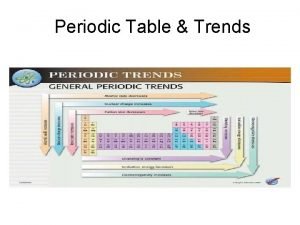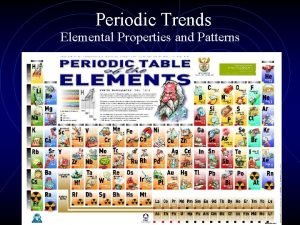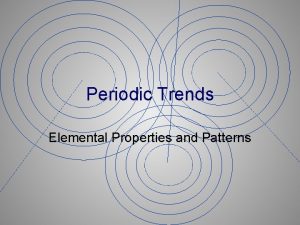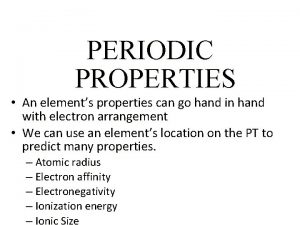periodic trends Periodic Trends properties that show patterns



























- Slides: 27

periodic trends

Periodic Trends: properties that show patterns when examined across the periods or vertically down the groups • While there are many periodic trends, we focus on 1. oxidation numbers 2. atomic radius 3. ionic size 4. ionization energy 5. electronegativity 6. Reactivity

Predicting Oxidation Numbers • When an atom forms an ion, the stability of an octet of e- enables you to predict the number of eto be gained or lost. You can then predict the charge on the ion formed. • Oxidation Number - the electrical charge resulting from atoms gaining or losing electrons to fill their outermost s and p orbitals – Metals have (+) oxidation numbers (cations) – Nonmetals have (–) oxidation numbers (anions) – All Noble Gases have an oxidation number of zero (0)

Predicting Oxidation Numbers 1+ 2+ 3 Tend to have more than one or oxidation state 4+ 3+ 3+ or 4+ 2 - 1 - 0

Why trends? • Atomic structure and Coulombic attractions are responsible for the patterns in the following periodic properties • Specifically : – The attraction between protons in nucleus and valence electrons (nuclear charge) – The repulsion between electrons and other electrons in the electron cloud (shielding effect)

Nuclear charge • Nuclear charge – the net positive charge experienced by an electron from the attractive force of the proton in nucleus • Nuclear charge increases across a period – The number of protons increases but the energy level and number of core (inner) electrons stays the same

Nuclear charge PRACTICE: From each of the following pairs of atoms, select the atom that feels a GREATER force from the nucleus. 1. Na, Cl Cl – more nuclear charge 2. Se, Ca Se-more nuclear charge

Shielding Effect / energy levels DEFINITION: Inner e- shield the valence e- from the attractive force of the nucleus. Caused by inner e - and valence e- repelling one another v. e– Li v. e– K TOUGHER TO REMOVE EASIER TO REMOVE

Shielding Effect GROUP TREND: TOP to BOTTOM INCREASES • New energy levels filled with electrons that shield the nucleus PERIODIC TREND: LEFT to RIGHT DOES NOT CHANGE • No change in the number of energy levels

Atomic Radius DEFINITION: One half the distance between the nuclei of two atoms of the same element when the atoms are bonded together

Atomic Radius GROUP TREND: TOP to BOTTOM INCREASES • New energy levels are added so the size of the electron cloud increases. PERIODIC TREND: LEFT to RIGHT DECREASES SLIGHTLY • No new energy levels are added • the “nuclear charge” increases by one proton for each element in the period. This pulls the electron cloud in a little tighter.

Atomic Radius

Atomic Radius PRACTICE: From each of the following pairs of atoms, select the atom that is larger in radius. 1. B, C 1. B - less nuclear charge 2. P - more EL’s 2. N, P 3. Cl, O 3. Cl - more EL’s 4. Ca, Sc 4. Ca - less nuclear charge 5. Ar, Ne 5. Ar - more EL’s

Ionic Radius-Metals • Located on the left and center of the PT • Formed by loss of e • e-- e- repulsion becomes less • Nucleus is attracting fewer electrons TREND of METALS: Metallic ions are smaller than the atoms from which they are formed.

Ionic Radius-Nonmetals • Located on the right side of the PT • Formed by gain of e • e-- e- repulsion becomes greater TREND: Nonmetallic ions are larger than the atoms from which they are formed.

Ionic Radius

Ionic Radius PRACTICE: From each of the following pairs of atoms, select the atom that is larger in radius. 1. S or S 2 - 2. Ca or Ca 2+ 1. S 2 Non-metals: ions are larger due to greater e- repulsion 2. Ca Metals: ions are smaller due to stronger pull on less e -

Ionization Energy DEFINITION: the energy required to remove the highest energy e- from a neutral atom GROUP TREND: TOP to BOTTOM DECREASES • Shielding effect and distance of outermost electrons from the nucleus increases due to addition of energy levels. Less energy is required to remove e-. PERIODIC TREND: LEFT to RIGHT INCREASES • Shielding effect is constant, but nuclear charge increases. More energy is required to remove e-.

Ionization Energy

Ionization Energy PRACTICE: From each of the following pairs of atoms, select the atom that has a lower first ionization energy. 1. Be, Mg 1. Mg-greater shielding, larger radius 2. Al, P 2. Al-smaller nuclear charge

Electronegativity DEFINITION: the measure of the ability of atom to attract electrons when the atom is in a compound Low electronegativity = Atoms with little tendency to gain e- (metals) Lowest: Cesium and Francium at 0. 7 High Electronegativity = Atoms that tend to gain eeasily (nonmetals Highest: Fluorine at 4. 0

Electronegativity GROUP TREND: TOP to BOTTOM DECREASES • Shielding effect and distance of outermost electrons from the nucleus increases due to addition of energy levels. Less attraction for e-. PERIODIC TREND: LEFT to RIGHT INCREASES • Shielding effect is constant, but nuclear charge increases. More attraction for e-.

Electronegativity

Electronegativity PRACTICE: Arrange the following elements in order of increasing electronegativity. 1. S, F, In, Se 1. In < Se < S < F 2. Fr, Ga, Ge, P, Zn 2. Fr < Zn < Ga < Ge < P

Reactivity of Metals GROUP TREND: TOP to BOTTOM MORE REACTIVE • A “larger” atom (more EL’s) will have less attraction for e- due to increased shielding • e- are more easily “lost” (i. e. , less pull from nucleus) from larger atom metals

Reactivity of Nonmetals GROUP TREND: TOP to BOTTOM LESS REACTIVE • A “smaller” atom (fewer EL’s) will have greater attraction for e- due to less shielding • e- are more easily “gained” (i. e. , more pull from nucleus) from smaller atom nonmetals

Reactivity PRACTICE: Arrange the following elements in order of decreasing reactivity. 1. K, Na, Rb, Li 1. Rb < K < Na < Li Metals 2. I, Br, F, Cl 2. F < Cl < Br < I Nonmetals
 A visual aid used to show statistical trends and patterns.
A visual aid used to show statistical trends and patterns. A visual aid used to show statistical trends and patterns
A visual aid used to show statistical trends and patterns Periodic trends in properties of elements
Periodic trends in properties of elements Nuclear charge definition
Nuclear charge definition Periodic trends in properties of elements
Periodic trends in properties of elements Periodic trends in elemental properties
Periodic trends in elemental properties Periodic trends in elemental properties
Periodic trends in elemental properties 15/999 mass street periodic table, o 8
15/999 mass street periodic table, o 8 Phân độ lown ngoại tâm thu
Phân độ lown ngoại tâm thu Block xoang nhĩ độ 2
Block xoang nhĩ độ 2 Thể thơ truyền thống
Thể thơ truyền thống Thơ thất ngôn tứ tuyệt đường luật
Thơ thất ngôn tứ tuyệt đường luật Walmart thất bại ở nhật
Walmart thất bại ở nhật Tìm độ lớn thật của tam giác abc
Tìm độ lớn thật của tam giác abc Con hãy đưa tay khi thấy người vấp ngã
Con hãy đưa tay khi thấy người vấp ngã Tôn thất thuyết là ai
Tôn thất thuyết là ai Gây tê cơ vuông thắt lưng
Gây tê cơ vuông thắt lưng Sau thất bại ở hồ điển triệt
Sau thất bại ở hồ điển triệt Dating patterns since the 1960s are
Dating patterns since the 1960s are Closed patterns and max-patterns
Closed patterns and max-patterns Atomic radii trend
Atomic radii trend Atomic radius
Atomic radius Trends on periodic table
Trends on periodic table Chemistry periodic table cheat sheet
Chemistry periodic table cheat sheet Ap chemistry chapter 7 atomic structure and periodicity
Ap chemistry chapter 7 atomic structure and periodicity Graphing periodic trends
Graphing periodic trends Oxidation trends periodic table
Oxidation trends periodic table Periodic trends electronegativity
Periodic trends electronegativity
















































